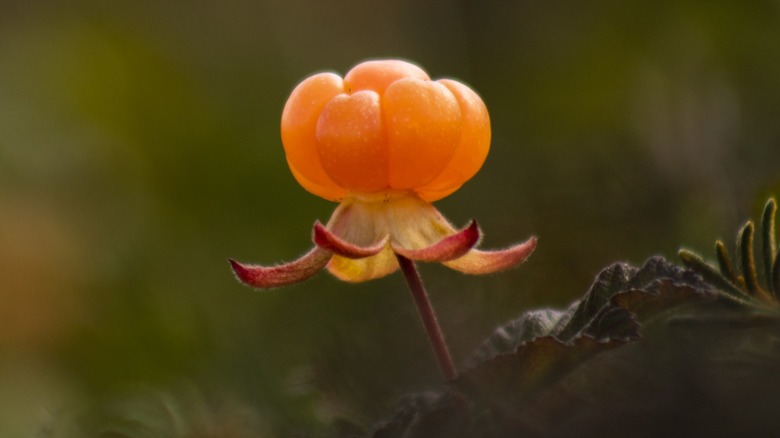The Rare Scandinavian Fruit That Dates Back To The Vikings
A cloudberry might sound like something out of a fever dream, but these tiny, elusive fruits exist in some of the wildest parts of Scandinavia. Tracking down the colorful raspberry-looking pieces can be akin to mining gold in a stream, as the polar places where the orange and yellow berries grow aren't well known and can be difficult to reach. "As a Swedish people, we say it's the gold of berries," Chef Emma Bengtsson told the Michelin Guide.
Cloudberries can take years to grow, and one plant offers only a single piece of fruit to collect during a few months in July (and only if conditions are just right). As you might expect, buying the harvested pieces will put a significant dent in your pocketbook. A 5-pound purchase of frozen cloudberries can run several hundred dollars. And that's if you can even find one! Cloudberries should certainly be included on the list of fruits uncommon in the U.S. that you should try at least once.
Before cloudberries were costing chefs pretty pennies, Vikings would stash the tiny fruits to take with them on extended adventures. Since these obscure pieces pack a significant amount of vitamin C, explorers would eat them to prevent scurvy. Cloudberries also offer antioxidants and vitamins A and E. Not only the fruit, but both the roots and leaves of the plant have also been used medicinally by the Arctic's Saami people to treat and prevent sickness.
Cloudberries have a unique flavor and many uses
Cloudberries can also be called salmonberries, bakeapples, or yellowberries. Today, the fruits are often incorporated into dessert and drink recipes. Cloudberry-flavored liqueur can be purchased for use in cocktails, and the fruits can be made into jams and preserves. When pressed into an oil, cloudberry extract can also be applied topically to promote good skin health and fight signs of aging.
The flavor of cloudberries can be hard to describe, however, as the taste of the berry will evolve as the fruit ripens. "On their own, there are hints of raspberry, mango, apricot and passionfruit; we find that extracting the nectar brings flavors of yeast, citrus, and concentrated watermelon," Chef John Shields explained to Farm Flavor. The tart, sweet fruits can add delicate floral notes to dishes.
The bright ingredient has long held a reputation at the groundbreaking Nordic restaurant, Noma as an integral part of a cold soup served with candied pinecones and frozen yogurt. We imagine that these coveted pieces could make a pretty tasty batch of akutaq ice cream, too — if you can get your hands on the fruit without breaking your budget.

